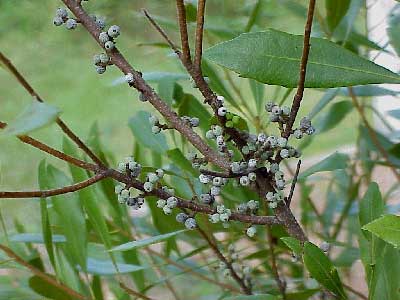
Wax Myrtle
by Sharon LaPlante
An
aromatic evergreen shrub, in the Myricaceae
or bayberry family, wax myrtle (Myrica cerifera) can reach 25 feet in
height at maturity. It commonly produces multiple trunks and sends out runners
that produce new
Wax myrtle can be found growing in a wide variety of habitats throughout
Its leaves are alternate, simple, narrowly oblanceolate and toothed at the apices (tips). Medicinally the leaves have been used to treat a variety of ailments such as stomach ulcers, skin ulcers, and colds. A gargle made from the leaves and bark is said to relieve a sore throat. Leaves may also be used as a substitute for bay leaf in culinary recipes and crushed leaves rubbed on the skin are purported to repel insects.
Its flowers are in the form of catkins that are born in the leaf axils. The catkins are approximately 3/4 inch long and appear in early spring. Male and female flowers are found on separate plants (dioecious). The flowers appear in great profusion and attract many insects which in turn attract many birds, especially winter warblers.
The fruit is a small, round, waxy berry (actually a drupe) that is approximately 1/8 of an inch in size. The berries are eaten by a wide variety of birds. Early colonists used the berries to make scented candles. The berries were boiled in water and the wax skimmed from the surface. Another common name that may be familiar is bayberry.
Its ability to thrive in an array of habitats makes it an excellent landscape plant. It will tolerate wet to dry soils and salt spray. Depending upon how it is pruned it can be either a hedge plant or specimen. The trunks can be pruned of lower branches creating a multi trunked tree, or you can pruned it back each year to produce more abundant lower foliage for a dense hedge. When grown in too much shade it can get very leggy and leaning.
Propagation is achieved through cuttings or seeds. Soaking the seeds in hot water or rubbing them on a rough surface helps to scarify the seed and remove the waxy coating. Stratification, or exposure to cold temperatures, is not required. Cuttings should be taken from semi-hardwood in the early summer. Rooting hormone can be used, but the time of year for collecting the cuttings seems to be most important. Root cuttings or removal of runners can be done throughout the year. Keep an eye out for seedlings coming up in your yard compliments of the fruit eating birds.
There are two other species in Florida, Myrica inodora, which is found in the panhandle, and M. heterophylla, which is found in the northern half of the state. A dwarf form is often seen at landscape nurseries, but there is some controversy as to whether or not the dwarf wax myrtle, M. cerifera var. pumila, is truly a distinct and separate species.
Bit, Richard E. Growing & Propagating Showy Native Woody Plants. University of North Carolina Press: N.C. 1992
Godfrey, R.K., and J.W. Wooten. Trees, Shrubs, and Woody Vines of Northern Florida and Adjacent Georgia and Alabama. University of Georgia Press: Athens, GA. 1981
Hutchens, Alma R. Indian Herbology of North America. Shambhala: Boston. 1973
Nelson, Gil. The Shrubs & Woody Vines of Florida. Pineapple Press: Sarasota, FL 1996
Peterson, Lee A. Peterson Field Guides: Edible Plants. Houghton Mifflin: Boston 1977
Return to the Main Page
All material on this site © Hernando Chapter of the FNPS. The materials on this website may be copied and distributed without permission, provided that it is used for non-commercial, informational or educational purposes, and you acknowledge this site and the Hernando Chapter of the Florida Native Plant Society as the source of publication.